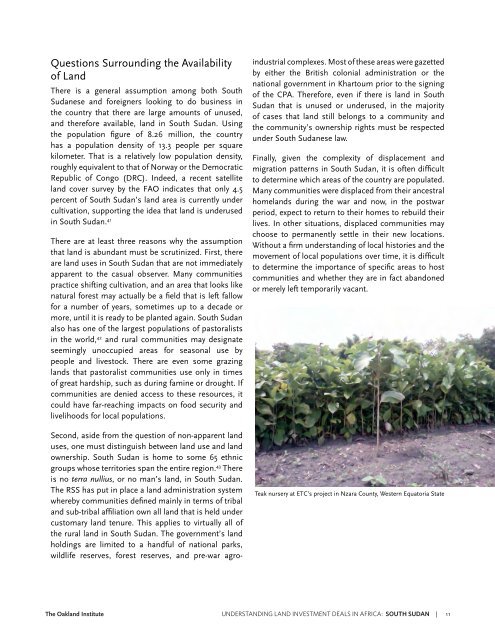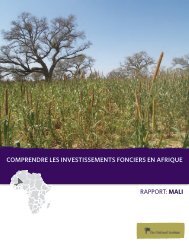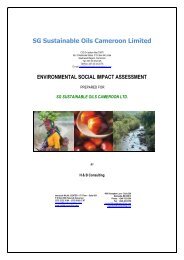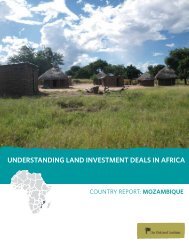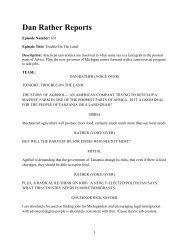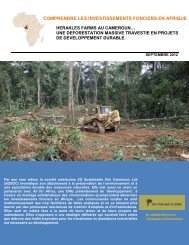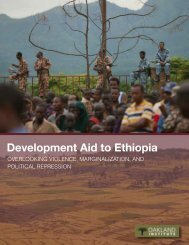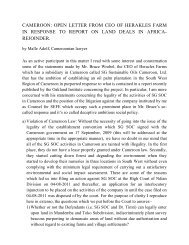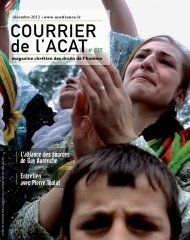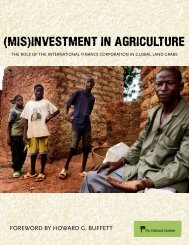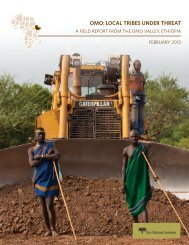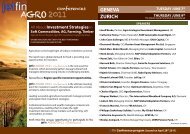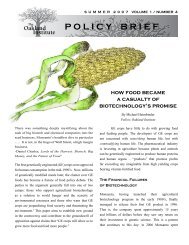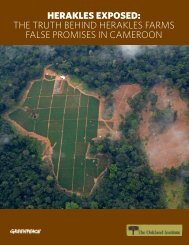understanding land investment deals in africa - Oakland Institute
understanding land investment deals in africa - Oakland Institute
understanding land investment deals in africa - Oakland Institute
- No tags were found...
Create successful ePaper yourself
Turn your PDF publications into a flip-book with our unique Google optimized e-Paper software.
Questions Surround<strong>in</strong>g the Availabilityof LandThere is a general assumption among both SouthSudanese and foreigners look<strong>in</strong>g to do bus<strong>in</strong>ess <strong>in</strong>the country that there are large amounts of unused,and therefore available, <strong>land</strong> <strong>in</strong> South Sudan. Us<strong>in</strong>gthe population figure of 8.26 million, the countryhas a population density of 13.3 people per squarekilometer. That is a relatively low population density,roughly equivalent to that of Norway or the DemocraticRepublic of Congo (DRC). Indeed, a recent satellite<strong>land</strong> cover survey by the FAO <strong>in</strong>dicates that only 4.5percent of South Sudan’s <strong>land</strong> area is currently undercultivation, support<strong>in</strong>g the idea that <strong>land</strong> is underused<strong>in</strong> South Sudan. 41There are at least three reasons why the assumptionthat <strong>land</strong> is abundant must be scrut<strong>in</strong>ized. First, thereare <strong>land</strong> uses <strong>in</strong> South Sudan that are not immediatelyapparent to the casual observer. Many communitiespractice shift<strong>in</strong>g cultivation, and an area that looks likenatural forest may actually be a field that is left fallowfor a number of years, sometimes up to a decade ormore, until it is ready to be planted aga<strong>in</strong>. South Sudanalso has one of the largest populations of pastoralists<strong>in</strong> the world, 42 and rural communities may designateseem<strong>in</strong>gly unoccupied areas for seasonal use bypeople and livestock. There are even some graz<strong>in</strong>g<strong>land</strong>s that pastoralist communities use only <strong>in</strong> timesof great hardship, such as dur<strong>in</strong>g fam<strong>in</strong>e or drought. Ifcommunities are denied access to these resources, itcould have far-reach<strong>in</strong>g impacts on food security andlivelihoods for local populations.Second, aside from the question of non-apparent <strong>land</strong>uses, one must dist<strong>in</strong>guish between <strong>land</strong> use and <strong>land</strong>ownership. South Sudan is home to some 65 ethnicgroups whose territories span the entire region. 43 Thereis no terra nullius, or no man’s <strong>land</strong>, <strong>in</strong> South Sudan.The RSS has put <strong>in</strong> place a <strong>land</strong> adm<strong>in</strong>istration systemwhereby communities def<strong>in</strong>ed ma<strong>in</strong>ly <strong>in</strong> terms of triba<strong>land</strong> sub-tribal affiliation own all <strong>land</strong> that is held undercustomary <strong>land</strong> tenure. This applies to virtually all ofthe rural <strong>land</strong> <strong>in</strong> South Sudan. The government’s <strong>land</strong>hold<strong>in</strong>gs are limited to a handful of national parks,wildlife reserves, forest reserves, and pre-war agro<strong>in</strong>dustrialcomplexes. Most of these areas were gazettedby either the British colonial adm<strong>in</strong>istration or thenational government <strong>in</strong> Khartoum prior to the sign<strong>in</strong>gof the CPA. Therefore, even if there is <strong>land</strong> <strong>in</strong> SouthSudan that is unused or underused, <strong>in</strong> the majorityof cases that <strong>land</strong> still belongs to a community andthe community’s ownership rights must be respectedunder South Sudanese law.F<strong>in</strong>ally, given the complexity of displacement andmigration patterns <strong>in</strong> South Sudan, it is often difficultto determ<strong>in</strong>e which areas of the country are populated.Many communities were displaced from their ancestralhome<strong>land</strong>s dur<strong>in</strong>g the war and now, <strong>in</strong> the postwarperiod, expect to return to their homes to rebuild theirlives. In other situations, displaced communities maychoose to permanently settle <strong>in</strong> their new locations.Without a firm <strong>understand<strong>in</strong>g</strong> of local histories and themovement of local populations over time, it is difficultto determ<strong>in</strong>e the importance of specific areas to hostcommunities and whether they are <strong>in</strong> fact abandonedor merely left temporarily vacant.Teak nursery at ETC’s project <strong>in</strong> Nzara County, Western Equatoria StateThe Oak<strong>land</strong> <strong>Institute</strong> <strong>understand<strong>in</strong>g</strong> <strong>land</strong> <strong><strong>in</strong>vestment</strong> <strong>deals</strong> <strong>in</strong> <strong>africa</strong>: south sudan | 11


